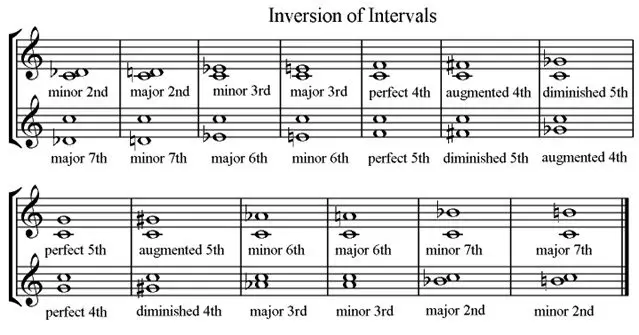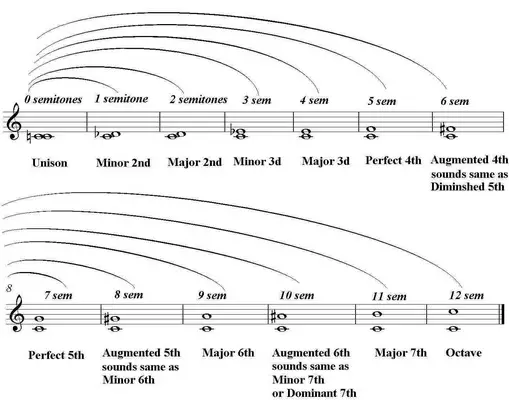
Musical intervals is the distance between two musical notes in semitones (I hope you remember that on the guitar each fret represents one semitone).
Music Interval is nothing but the distance between two notes or pitches. It is important to know about intervals as you can use them, besides chords, for harmonizing. It will also help you to figure out how all the scales are constructed.
The Different Music Intervals
Here are the various musical intervals that you will encounter when learning music theory.
- The music intervals that you will encounter are Seconds, Thirds, Fourths, Fifths, Sixths, Sevenths and
- Octave. These can further be classified as Major (M), Minor (m), Perfect (P), Augmented (A), and Diminished (d).
- The letters in the brackets are symbols which can also be used to identify them.
You will also hear terms such as semi-tones and whole-tones which are nothing but Minor-Second and Major-Second intervals.
More About Music Intervals
Here are the various music interval types.
Unison – 1
Second – 2nd
Third – 3rd
Fourth – 4th
Fifth – 5th
Sixth – 6th
Seventh – 7th
Octave – 8ve
Ninth – 9th
Tenth – 10th
Eleventh – 11th
Twelfth – 12th
Thirteenth – 13th
If we use the note C as the root note (of the scale or chord we’re working with), here are the various intervals that can be formed (symbols of the intervals are in parenthesis):
- C: the tonic, the root (T or R);
- Db, a semitone above the root: the minor second (b2 or m2);
- D, a whole-tone above the root: the major second (M2);
- D#, a whole-tone plus a semitone above the root: the augmented second (#2 or aug2);
- Eb, the same note as D# but with a different name (we’ll discuss this later): the minor third (b3 or m3);
- E, two whole-tones above the root: the major third (M3);

- F, two whole-tones plus a semitone above the root: the perfect fourth (P4);
- F#, three whole-tones above the root: the augmented fourth (#4 or aug4);
- Gb, the same note as F#: diminished fifth (b5 or dim5);
- G, three whole-tones plus a semitone above the root: perfect fifth (P5);
- G#, four whole-tones above the root: augmented fifth (#5 or aug5);
- Ab, the same note as G#: minor sixth (b6 or m6);
- A, four whole-tones plus a semitone above the root: major sixth (M6);
- Bbb (this note is one whole-tone below B because it has two flats!), the same note as A: diminished seventh (bb7 or dim7);
- Bb, five whole-tones above the root: minor seventh (b7 or m7);
- B, five whole-tones plus a semitone above the root: major seventh (M7).
After that, the seconds are called ninths, the fourths are called elevenths and the sixths are called thirteenths.

Though these are the various types, intervals also have another identifier in addition to the number, known as the interval quality. Music Intervals can be further called as (notice the symbol used to denote it):
Major (M)
minor (m)
Perfect (P)
Augmented (A), or
Diminished (d)
Here’s a correlation between Intervals, half-steps (semitones), and the type/identifier of music intervals:
P1, d2 = 0 half-steps
m2, A1 = 1 half-step
M2, d3 = 2 half-steps
m3, A2 = 3 half-steps
M3, d4 = 4 half-steps
P4, A3 = 5 half-steps
A4, d5 = 6 half-steps
P5, d6 = 7 half-steps
m6, A5 = 8 half-steps
M6, d7 = 9 half-steps
m7, A6 = 10 half-steps
M7, d8 = 11 half-steps
P8, A7 = 12 half-steps
Harmonic / Melodic
An interval can also be called Harmonic or Melodic depending on the way it is played.
- Harmonic – When you play the two notes simultaneously
- Melodic – When you play the two notes one after the other
Triad and Tetrad Formation
Instead of thinking about the triads and tetrads as stacked thirds, we can think about the intervals that each note forms with the root.
- MAJOR TRIAD: formed by root, major third and perfect fifth (C);
- MINOR TRIAD: formed by root, minor third and perfect fifth (Cm);
- AUGMENTED TRIAD: formed by root, major third and augmented fifth (Caug, C+);
- DIMINISHED TRIAD: formed by root, minor third and diminished fifth (Gdim, G°);
- MAJOR TETRAD: formed by root, major third, perfect fifth and major seventh (Cmaj7, C7+);
- DOMINANT TETRAD: formed by root, major third, perfect fifth and minor seventh (C7);
- MINOR TETRAD: formed by root, minor third, perfect fifth and minor seventh (Cm7, C-7);
- MAJOR AUGMENTED TETRAD: formed by root, major third, augmented fifth and major seventh (Cmaj7#5, C7+#5);
- DIMINISHED TETRAD: formed by root, minor third, diminished fifth and diminished seventh (C°7, Cdim7);
- HALF-DIMINISHED TETRAD: formed by root, minor third, diminished fifth and minor seventh (Cm7b5).
Related: More music theory lessons here.
KeytarHQ editorial team includes musicians who write and review products for pianists, keyboardists, guitarists & other musicians. KeytarHQ is the best online resource for information on keyboards, pianos, synths, keytars, guitars and music gear for musicians of all abilities, ages and interests.



Leave a Reply